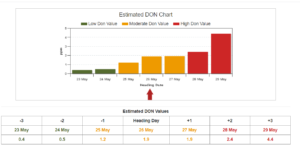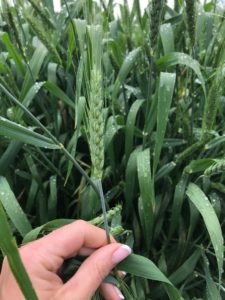With warmer temperatures wheat has really progressed across the province. Fields in southern Ontario are beginning to head out while fields further east and north are at or approaching flag leaf emergence. That being said, all herbicide applications should be wrapped up in those fields that are at or approaching flag leaf. Disease should be monitored for movement up the canopy until fusarium head blight (FHB) fungicide applications (T3) begin.
Given the warm temperatures are forecasted to stay into early next week, helping the wheat progress quickly, it is important to stay on top of staging to avoid missing the window for T3 applications. By adding up the average daily temperature, weekly Growing Degree Day (GDD) accumulations can be determined to help estimate when wheat may begin anthesis. Once the flag leaf has emerged and the flag leaf collar is visible, it takes about 250-270 GDDs to reach the beginning of anthesis. If the flag leaf has fully emerged today and there is an accumulation of about 20-25 GDDs per day, the wheat is expected to begin anthesis in about 10-14 days.
Winter wheat is most susceptible to FHB infection during anthesis. Spores are carried from infected crop residue by wind or rain and splash onto the wheat head. Rainfall or heavy dew during this period then causes the spores to germinate and infect florets on the wheat head. Wheat fields planted after corn or wheat or those planted to a susceptible variety are at most risk. To determine the susceptibility of a variety please visit www.GoCereals.ca under the performance tab.
Looking at the DONcast model, fields heading out in some areas the week of May 24th are at low risk while fields in other areas are showing moderate to high risk for DON accumulation. If the model suggests the risk for DON accumulation is medium to high and you are growing a susceptible or moderately susceptible variety a fungicide application is warranted. If the risk is low and you are growing a moderately resistant variety a fungicide application may not be necessary if persistent dry weather continues. For more information on DONcast please visit: http://www.4rcast.ca/.


T3 Fungicide Application Timing
Once 75% of the heads on the main stem reach GS59 (head emergence complete) this is known as “day 0” (figure 3). The optimum fungicide application timing is shortly after this on “day 2”. Day 2 is the beginning of pollination when anthers are visible on the middle of the wheat head (figure 4). This timing is critical because this is when the peak number of florets are open and susceptible to infection. If temperatures continue to be warm during this period it could result in the wheat crop moving quickly through these growth stages. This is why it is important to track wheat staging as it approaches heading (GS59).


While day 2 is the optimum time, T3 fungicides can be applied up to day 6 with good efficacy. Therefore, waiting an extra day or two and targeting day 3-6 may allow you to target more of the crop at the optimum time if the staging is not uniform. Two fungicide applications are not recommended as they are generally not economical, particularly in those fields with low yield potential.
Monitoring for Powdery Mildew
Powdery mildew continues to be reported at high levels in a number of fields, specifically those with susceptible varieties. To determine a varieties level of tolerance to powdery mildew refer to the Head to Head feature on Ontario Cereal Crop Committee (OCCC) website. Simply select the area the field is located in, the varieties being grown and powdery mildew. It will provide a rating score from 0 to 9. The higher the score, the more susceptible the variety is to powdery mildew. If the variety that has a high powdery mildew score then T2 (flag leaf) fungicide application may be considered to keep the disease from progressing up the canopy. If the variety is more tolerant of powdery mildew and disease is not progressing up the canopy, then a fungicide application may not be necessary until the T3 fungicide timing.
